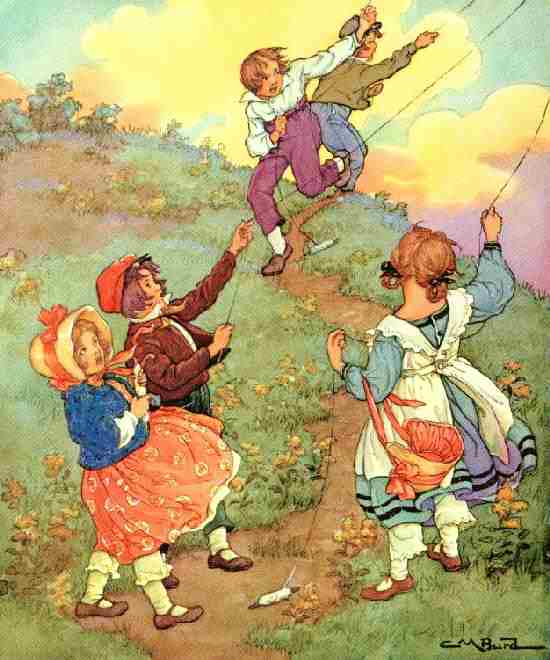
Illustrators: Clara M. Burd (American, 1910s-30s)

Figure 1.--This wondeful illustration by Clara Burd looks like it was set in the 1840s before the Civil War. The clothing seems reasonably accurate for that period, if charmingly idealized. The illustration was for an edition of Louisa May Alcott's "Little Men". The book was written in the 1870s and set in contemporary timesc (post-Civil War America). So the clothing styles are not a good reflection of those being worn for the setting of the book.
|
|
We note some beautiful images by Clara M. Burd from the 1910s through the 30s. We know very little about her at this time. She was an art student at the Chase School and National Academy of Design in New York. She then went to France and studied at Courtois and
Colarossi in Paris. Later she pursued portrait painting with Renardo and her work was received including awards. Her professional career pursued illustrating children's books, designing stained glass, and painting children's portraits. She often painting scenes from historical periods. They are lovely images, but we are unsure about their accuracy.
Family
Clara's parents were Charles Edgar Burd and Amelia Roe Burd of Patchogue, NY. Clara had a younger brother Charles Gillette Burd (1875- ). Charles first married Sarah Van Allen Collier. They had a daughter Margaret. Later he married Rebecca Tracey and then Hazel Webb. [Franklin]
Childhood
Clara Miller Burd born May 17,1873 at the home of the Burd grandparents (Broadway and 42nd Street at Times Square). [Franklin]
Education
We know nothing about Burd's early education. Clara attended schools in Patchogue, graduated high school. Her art training was quite extensive and varied. Burd was an art student at the Chase School and National Academy of Design in New York. She went on to the National Academy of Design in NY. In 1892, when she was 19 and an honor student, she received a medal of achievement from that school. Her teachers included portrait painter William Chase and C. T. Turner. In 1898, she went to Paris and worked under Courtois and Renardo. [Franklin] She next pursued a somewhat unsusal pursuit for artists,
Stained Glass
After returning to America, she studied stained glass design at the fanmed Tiffany studios in New York. She later worked at the J. & R. Lamb Company as well as with the Church Glass and Decoration Company. She has windows in the First Church id Christ, Pittsfield and in the West End Collegiate Church in NYC. She lived in Montclair, NY until her death in 1933 after having several teeth extracted.
Illustration Career
Burd is best known for her illustrations of children's books. Her career was, however, much more diverse. She designed magazine covers for some of the major publications of early 20th century America. The magazines included: Canadian Hone-Journal, Farmerís Wife, Hollandís, Literary Digest, Modern Priscilla, Womanís Home Companion, and Womanís World. She also painted some beauriful portraits of children. Persuing her interest in color, she did some important stained glass windows. Her most famous work was a memorial window for slain President McKinley in Ohio. She also designed many churches windows and often painted mural decorations for those churches as well.
We have only a few examples of Burds ilustrations at this time. She apparently liked to fraw idealized historical settings, often in the Kate Geenaway era of the early 19th century. She believed in the vibrant use of color. Some of her book illistratins are especially striking. We note in particular the illustrations for Jeannette Marks' The Children in the Wood Stories (Springfield, Milton Bradley, 1919), set in the medieval period. Although not one of her better known set of illusrations, they are quite beautiful. Perhaps her best known illustrations were for the Louisa Mae Alcott books Little Women (1926), Jo's Boys (1928), Little Men (1928), An Old Fashioned Girl (1928), and Eight Cousins (1931). There were also beautiful illustrations for an edition of Rovert Louis Stevenson's Child Garden of Verses. The illustration seen here is from that edition (figure 1). Another beautiful ser of illustrations was done for Elizabeth Lodor Merchant's Boys' Stories from Dickens (1929).
Clothing
She often painting scenes from historical periods. They are lovely images, but we are unsure about their accuracy. We stress that we are unsure about the acciracy, not that the illustrations are definitely inaccurate. We look at the illustration here. The boys' caps suggest to us the 1840s and 50s. The girl's bonnet also seems accurate. We note that the girls are wearing pinafores. We are not sure, however, when pinafores became such a standard girl's garment. We know that they were very commomn during the late 19th century. We are unsure how common they were during the 1830s-50s. Also notice the pantalettes. Here we think this may well be an accurate depiction of the 1830s-50s.
Sources
Franklin, Tricia. E-mail message, February 9, 2004.
HBC

Navigate the Boys' Historical Clothing Artist pages:
[Return to the Main individual American illustrator page]
[Return to the Main individual illustrator page]
[Chronology]
[Countries]
[Individuals]
[Styles]
Navigate the Boys' Historical Clothing Web Site:
[Introduction]
[Activities]
[Biographies]
[Chronology]
[Clothing styles]
[Countries]
[Literary]
[Bibliographies]
[Contributions]
[FAQs]
[Glossaries]
[Images]
[Links]
[Registration]
[Tools]
[Boys' Clothing Home]
Created: September 12, 2002
Last updated: February 9, 2004



